
Frontier Technology Issues: Can digital technologies put us back on the path to achieve the SDGs?
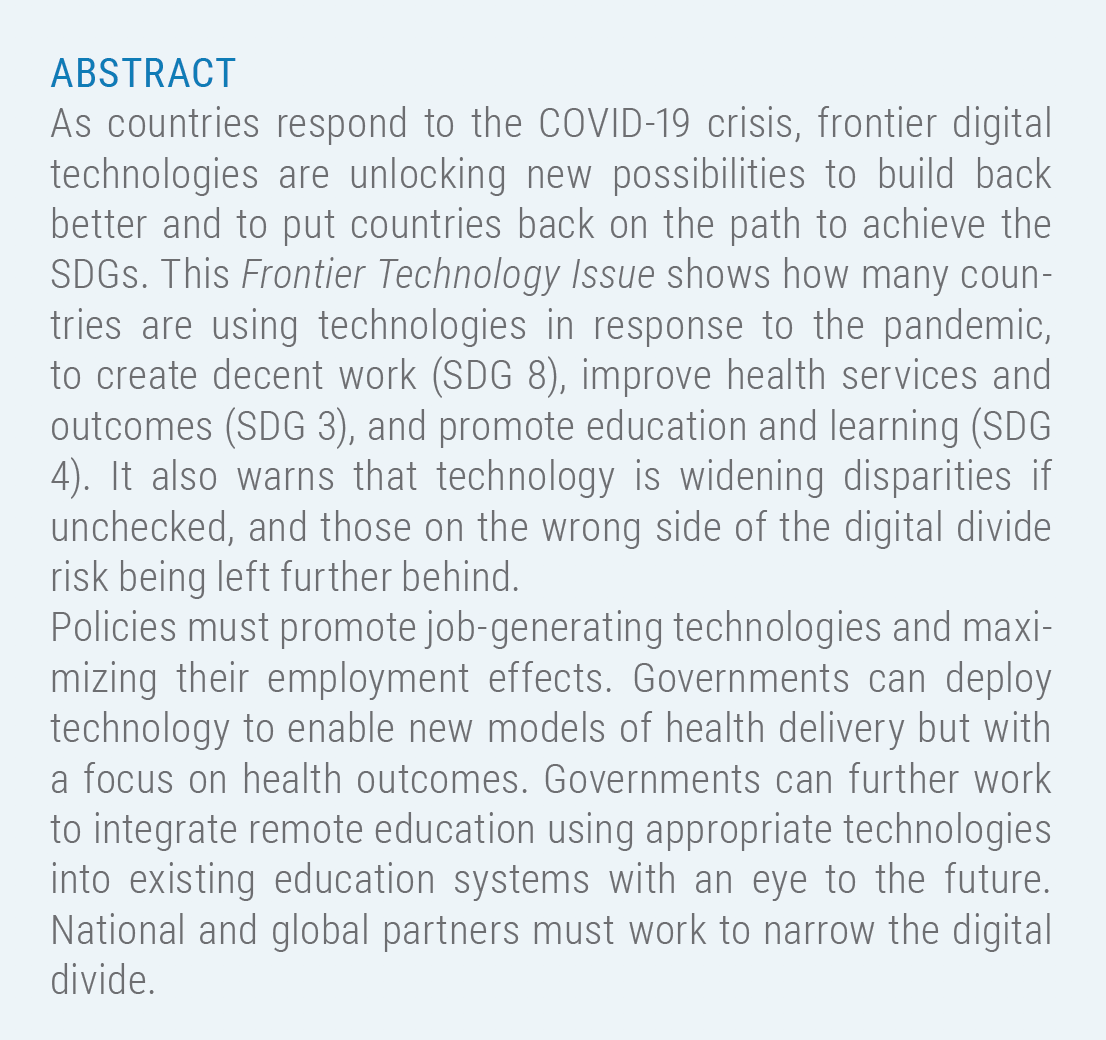 Introduction
Introduction
As countries respond to the COVID-19 crisis, frontier digital technologies are unlocking new possibilities to build back better and to put countries back on the path to achieve the SDGs. This Frontier Technology Issue (FTI) focuses on the role of digital technologies to contribute to positive outcomes in three areas deemed important in the aftermath of the COVID-19 crisis: creating economic growth and decent work (SDG 8), combating the virus and improving public health and well-being (SDG 3), and providing high-quality education to all (SDG 4).
This FTI also discusses how digital technologies are widening disparities and are accentuating the digital divide in societies and between developed and developing countries. Many of those who are most vulnerable to the effects of the virus—older persons, persons with disabilities, indigenous people, children, migrants, refugees, and informal workers— are also most likely to have less access to digital connectivity and technologies, especially in developing countries.1 Families with low digital literacy are less likely to use flexible work arrangements, are less likely to have the Internet connection necessary for distant learning; and are less likely to use telemedicine via mobile devices. There is a wide variation in the quality and coverage of digital infrastructure among countries. The digital divide and its implications are cross-cutting issues addressed throughout the paper.
This FTI is organized as follows. Section 1 discusses the potential of frontier technologies to contribute to positive labour market outcomes in the post COVID-19 world. Section 2 looks at how digital technologies can help improve health services and health outcomes. Section 3 discusses the role of technologies in promoting education and learning. Section 4 concludes with some policy suggestions on how to build back better and ensure faster SDG progress in these areas, avoiding the possible pitfalls.
1. Contribution of technologies to the evolution of labour markets
In recent years, the world has witnessed a new wave of concerns over the negative impacts of technologies on labour markets. Much has been discussed about how technologies add to work-related insecurity. Robots and artificial intelligence (AI) are replacing a larger share of existing jobs, with a recent estimate suggesting that 8.5 per cent of the global manufacturing workforce could be displaced by industrial robots by 2030 (Oxford Economics, 2019). Some technology-induced changes in the organization of economic activities, such as the rise of the gig economy, have left workers less protected. A 2017 survey of 1,200 workers across four online platforms revealed that around 70 per cent of these workers could not access basic social protection schemes, with the exception of healthcare insurance (Forde et al., 2017). Also, the uneven access to technologies means that the benefits that technologies bring are unevenly distributed across workers, which could further economic inequality.
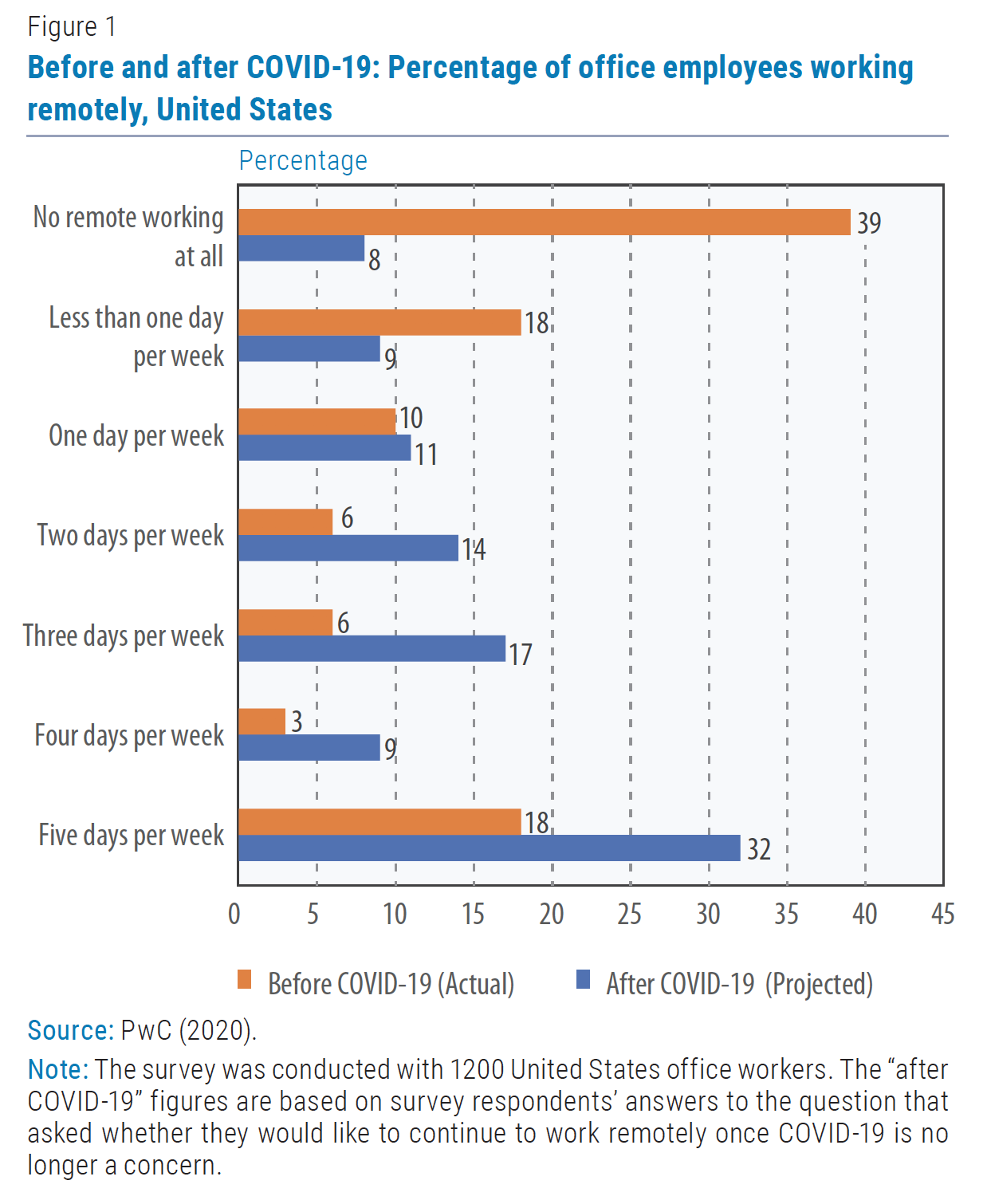 At the same time, frontier technologies have the potential to contribute to positive labour market outcomes in the post COVID-19 world, helping countries to build back better. With careful application, frontier technologies can be leveraged to generate decent work that is safe, productive and delivers a fair and secure income and to provide good social protection and vocational training that are commensurate with the labour market situation. Some of these potentials are COVID-specific, while other potentials have existed pre-COVID but are now being amplified by the changes in the labour market caused by the pandemic. Ultimately, whether these potentials would be broadly realized and be substantial enough to counteract technologies’ negative labour market effects would depend on policies, which will be discussed in the last section of this paper. The pandemic has accelerated the shift to remote work. As it reduces in-person contact, remote working helps to contain the pandemic, laying the foundation for building back better. And when working from home is not feasible, technologies can be used to better detect COVID symptoms, and to ensure that good public health practices, such as social distancing and face covering, are implemented at work. For example, personal tracking devices and cameras can be used to monitor workers’ distance from their colleagues and persons with a high-risk of pandemic contagion (Khalid, 2020). The use of such technologies, however, must not relieve employers of their responsibility concerning aspects of workplace safety that they control, such as worker spacing, physical barriers between workstations, availability of personal protective equipment and adequate handwashing breaks (Amrute, Rosenblat and Callaci, 2020). Precautionary measures must also be taken to protect worker privacy when these surveillance technologies are employed.
At the same time, frontier technologies have the potential to contribute to positive labour market outcomes in the post COVID-19 world, helping countries to build back better. With careful application, frontier technologies can be leveraged to generate decent work that is safe, productive and delivers a fair and secure income and to provide good social protection and vocational training that are commensurate with the labour market situation. Some of these potentials are COVID-specific, while other potentials have existed pre-COVID but are now being amplified by the changes in the labour market caused by the pandemic. Ultimately, whether these potentials would be broadly realized and be substantial enough to counteract technologies’ negative labour market effects would depend on policies, which will be discussed in the last section of this paper. The pandemic has accelerated the shift to remote work. As it reduces in-person contact, remote working helps to contain the pandemic, laying the foundation for building back better. And when working from home is not feasible, technologies can be used to better detect COVID symptoms, and to ensure that good public health practices, such as social distancing and face covering, are implemented at work. For example, personal tracking devices and cameras can be used to monitor workers’ distance from their colleagues and persons with a high-risk of pandemic contagion (Khalid, 2020). The use of such technologies, however, must not relieve employers of their responsibility concerning aspects of workplace safety that they control, such as worker spacing, physical barriers between workstations, availability of personal protective equipment and adequate handwashing breaks (Amrute, Rosenblat and Callaci, 2020). Precautionary measures must also be taken to protect worker privacy when these surveillance technologies are employed.
The shift to remote work also provides more options and flexibility to employers and employees, in terms of work locations and work hours. The COVID-19 pandemic has compelled countries to experiment with remote working on a massive scale and has demonstrated its feasibility for many. To illustrate, a United States survey shows that only 8 per cent of office employees would not like to work remotely to some extent after the pandemic, a significant decline from the 39 per cent reported in the pre-COVID-19 time (Figure 1). Notably, respondents who want to work fully remote after the pandemic, i.e. five days a week, see the greatest spike, jumping to 32 per cent of all respondents. Remote working might also be desirable from the standpoint that it allows workers to move away from densely populated urban areas that are often plagued by development and governance challenges posed by rapid urbanization.
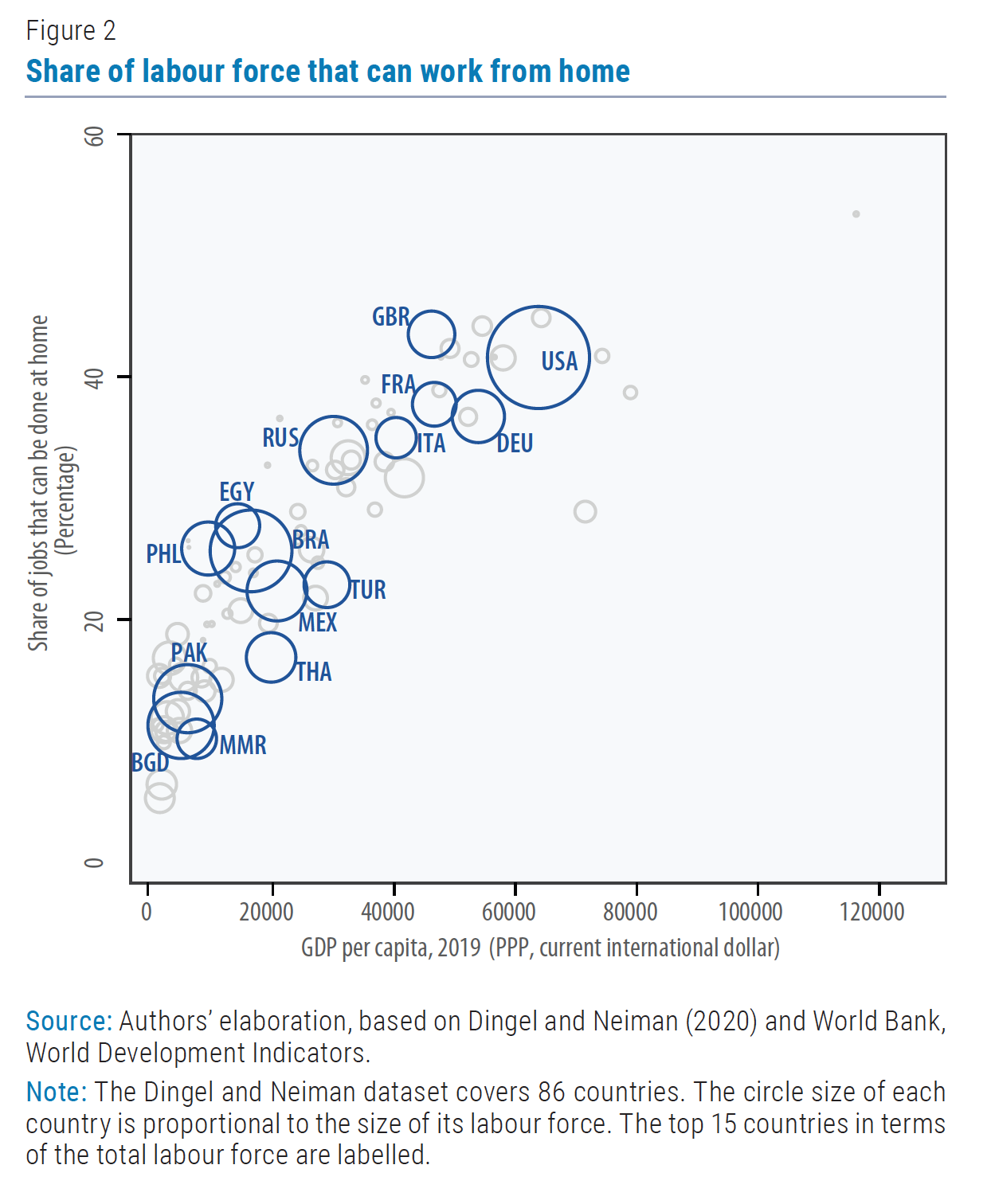 How much of a country’s labour force can work remotely and enjoy the benefits that it entails depends on its economic structure and access to digital technologies and infrastructures. Countries with lower income levels tend to have a smaller share of its labour force that can work from home (see Figure 2). Even for countries with high teleworkability, there is still typically more than half of the workforce that cannot work remotely. Furthermore, it is the more disadvantaged groups that are less likely to fully benefit from this digital transformation. These include low-paid workers—many of whom are women—employed in sectors that cannot or have not embraced digitalization, and low-income and/or rural households that have inadequate access to technologies. In general, workers with less education are less likely to have jobs that allow remote working. For example, in the case of Canada, fewer than 30 per cent of primary income earners with a high school diploma can work from home, whereas about two-thirds of their counterparts with a bachelor's degree or higher education can work remotely (Messacar, Morissette & Deng, 2020). Certain frontier technologies can make some economic production less dependent on agglomeration, and consequently change the spatial distribution of work going forward. The source of agglomeration efficiency is typically attributed to the better matching of workers and employers, more global and dynamic peer learning and flows of ideas, more efficient sharing of local infrastructures, business services, intermediate suppliers, and ease to specialize. Frontier technologies have the possibility of at least partially replicating some of these advantages without necessitating the physical clustering of economic actors. Rapid advances in, and widespread use of, information and communication technologies mean efficient matching in the labour market is possible even if workers and employers are not geographically situated at the same place. There are also many channels for people to exchange ideas in the digital sphere regardless of where they are.
How much of a country’s labour force can work remotely and enjoy the benefits that it entails depends on its economic structure and access to digital technologies and infrastructures. Countries with lower income levels tend to have a smaller share of its labour force that can work from home (see Figure 2). Even for countries with high teleworkability, there is still typically more than half of the workforce that cannot work remotely. Furthermore, it is the more disadvantaged groups that are less likely to fully benefit from this digital transformation. These include low-paid workers—many of whom are women—employed in sectors that cannot or have not embraced digitalization, and low-income and/or rural households that have inadequate access to technologies. In general, workers with less education are less likely to have jobs that allow remote working. For example, in the case of Canada, fewer than 30 per cent of primary income earners with a high school diploma can work from home, whereas about two-thirds of their counterparts with a bachelor's degree or higher education can work remotely (Messacar, Morissette & Deng, 2020). Certain frontier technologies can make some economic production less dependent on agglomeration, and consequently change the spatial distribution of work going forward. The source of agglomeration efficiency is typically attributed to the better matching of workers and employers, more global and dynamic peer learning and flows of ideas, more efficient sharing of local infrastructures, business services, intermediate suppliers, and ease to specialize. Frontier technologies have the possibility of at least partially replicating some of these advantages without necessitating the physical clustering of economic actors. Rapid advances in, and widespread use of, information and communication technologies mean efficient matching in the labour market is possible even if workers and employers are not geographically situated at the same place. There are also many channels for people to exchange ideas in the digital sphere regardless of where they are.
Additive manufacturing technologies—a product of computer- aided design and material science, increasingly enhanced by AI—also present some opportunities to move economic activities, and therefore jobs, away from the densely-populated cities. Compared to the standard manufacturing method, additive manufacturing is less capital-intensive and requires less upfront fixed investment, which means economies of scale would be less of a factor for reducing per-unit production cost. It reduces the need for manufacturing-related employment to aggregate in urban areas, which helps to create a labour market that is not so heavily tilted towards cities. In the case of the United States which leads the world in 3D printing spending, more than two-thirds of manufacturers were already using 3D printing in some way in 2016 (PwC and Manufacturing Institute, 2016). Whether or not its commercial potential can be realized at broad geographic scales would be conditional on further lowering of cost and development of relevant expertise to use the technology.
As the COVID-19 pandemic has caused significant unemployment in many countries, digital technologies should be leveraged to help workers to transition into new jobs and new industries. Countries that had their worker-support services, such as job-matching and guidance for the unemployed, digitalized before the pandemic have been able to support their workers better during the crisis (Avila and Mattozzi, 2020). For example, Estonia adopted a multi-channel service delivery strategy in 2018 to provide clients with several ways to access employment services, including online applications, webinars, and online conversational chats. Before COVID-19, the digitalized Estonian public employment service system allowed unemployment insurance claims to be processed in less than a minute, and this system was expanded to process the large number of claims received during the pandemic with similar speed.
Technologies can also be used to improve worker skills and rights—the importance of which has been accentuated in the deteriorated labour market where so many workers have been laid off, furloughed, or have their work schedule or wages cut. Technologies create opportunities to provide apprentice-like learning and online training programmes to a growing number of occupations. An example is the utilities sector where virtual reality technologies have been used to train staff to perform procedures to service, repair and maintain equipment, improving efficiency and reducing risks for workers (Cohen et al., 2018). Information and communication technologies that enable unions to reach more workers in less time can be used to update all parties about labour rights and obligations, strengthen collective bargaining and improve labour relations institutions and processes. For example, there are apps developed to ensure hourly workers are being fully paid and to allow comparison of wages among workers in similar positions, which help to reduce labour exploitation (Malcolm, 2016). Interviews with 658 online workers in sub-Saharan Africa and South-East Asia showed that close to 60 per cent have weekly digital contact with other workers, mostly on social media, discussing wage negotiations and how to avoid scams, and the like (The Economist, 2018). And with the extensive deployment of digital tools, Coworker. org—a labour organizing platform—helps over 42,000 Starbucks employees in 30 countries to connect.
2. Using digital technologies to improve health services and outcomes
According to the World Health Organization (WHO), in 2017 only between 33 and 49 per cent of the global population was covered by essential health services. In low-income countries, the coverage was only between 12 and 27 per cent. Before COVID-19, the WHO expected global coverage to increase to between 39 and 63 per cent by 2030, significantly below the target of full coverage (WHO, 2020). Achieving the targets under SDG 3 (good health and wellbeing) would mean preventing 97 million premature deaths through 2030, including more than 50 million infants and children who die before their fifth birthday (Hatefi, 2017; WHO, 2017).
Providing quality, timely, and adequate care to the underlying population as described in SDG 3 requires improving the supply and demand of healthcare as well as the quality and the cost of services. Unfortunately, the COVID-19 crisis has made this challenge more difficult by disrupting the essential health services on which so many depend (UN DESA, 2020). At least 24 million people in 21 lower-income countries are at risk of missing out on vaccines against polio, measles, typhoid, yellow fever, and many other diseases. A six-month-long disruption in HIV services could lead to more than 500,000 additional deaths in 2020–2021 from AIDS related illnesses in sub-Saharan Africa. A 25 per cent reduction in detection of tuberculosis for only 3 months would mean a 13 per cent rise in deaths. Disruptions to malaria-prevention campaigns and severe disruptions in treatment in sub-Saharan Africa could lead to twice as many deaths in 2020 as in 2018 (United Nations Statistics Division, 2020).
Digital technologies that leverage mobile networks and devices (known as mHealth) can help to mitigate the above-noted disruptions to health services. Figure 3 provides a roadmap of the many ways technologies can help build back better health systems and improve health outcomes. It shows a conceptual model of the “stack” of functions that are required to address the health needs of a target population. In this framework, achieving universal health coverage and providing quality, timely, and adequate care to the underlying population requires improving the performance of health services across multiple layers of accountability, supply, demand, quality, and cost. Each layer builds on the progress of the layer below.
In Figure 3, digital technologies—depicted as strategies A through H—can improve overall results in each functional layer. Digital technologies increase the demand for health services by providing health education on when to seek screening, exams and treatment, particularly in remote areas (strategy E). Social media can spread knowledge on women’s health and contraception, vaccination and immunization, hygiene and sanitation, and pandemic and epidemic response. According to the WHO’s latest eHealth survey (covering 2015), nearly 80 per cent of countries promote health messages using social media and 83 per cent had at least one mHealth initiative (WHO, 2016). The survey also identified the growing use of telehealth, particularly teleradiology in 77 per cent of the countries. Other services, such as telepathology, remote patient monitoring and teledermatology, were in use in nearly half of the countries.
Digital technologies help reduce the cost of services by leveraging widely used commodity devices such as smartphones, tablets, and cameras (strategy G). For instance, it is now possible for community volunteers to use smartphones to test the eyesight of patients in the most remote locations. The system is part of a platform that also generates referrals for treatment, sends notifications to patients and can track service delivery. An estimated 1 billion people in the world have a visual impairment that is treatable or could have been prevented.
Volunteer community health workers and midwives in Kenya, with portable technologies and digital devices carried in a backpack, can bring much-needed care to improve child and maternal health. The pack includes a wind-up fetal doppler used for measuring the baby’s heartbeat, a portable ultrasound screen, sensors to measure blood oxygen levels, in-ear thermometers, and other medical instruments related to pregnancy. These volunteers are usually the first to detect problems with unborn babies, newborns and mothers needing immediate medical attention. Digital data also enables innovative service delivery. A company called Zipline leveraged digital connectivity to create physical connectivity using drones to deliver medical supplies (medicines, blood) to health clinics in remote locations in Ghana and Rwanda. The drone delivery service relies on communication links between health providers and brings emergency and on-demand access to critical and life-saving medicines through a national delivery network capable of making hundreds of deliveries each day from each of its regional medical distribution centers. The COVID-19 pandemic has elevated the importance of digital models of healthcare delivery that reduce in-person interactions (strategies C-H). Technologies are offering new options and solutions for healthcare providers, developers of health technologies, the population, and public health agencies.
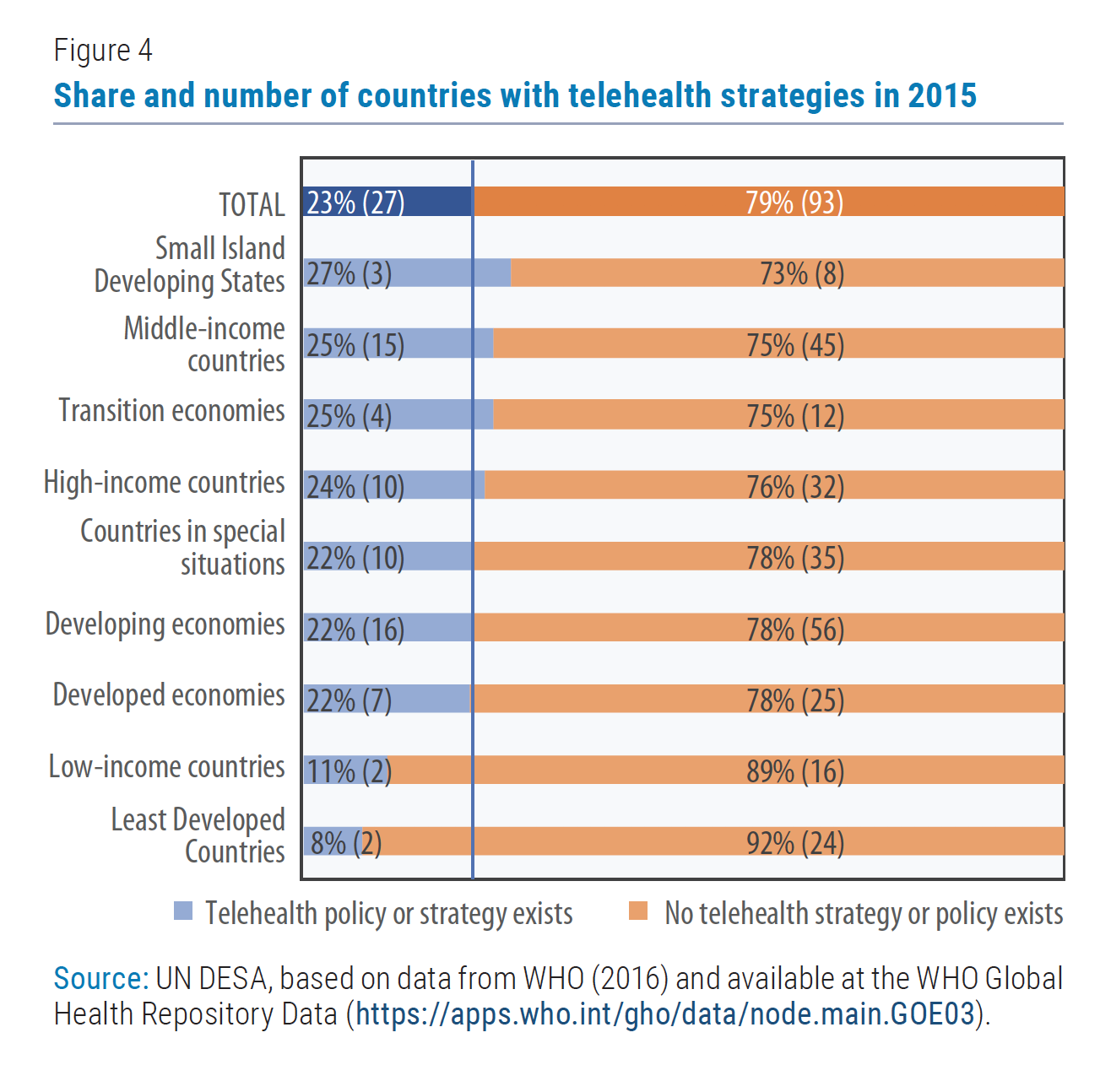 Healthcare providers are using telehealth platforms for virtual visits, mobile apps for remote patient monitoring and risk assessment, and websites and chatbots for screening and triage. Prior to the COVID-19 pandemic, 23 per cent of countries surveyed by the WHO had national strategies to expand telehealth services (Figure 4). Low-income countries and least developed countries were significantly less likely to have a strategy. It is reasonable to expect that more countries will develop and implement such plans. In one study of more than 50,000 medical providers in the United States, demand for telehealth visits increased by 14 per cent between early-March and early-April 2020. In contrast, in-person visits declined by nearly 70 per cent during that period (Figure 5). Remote connectivity also enables doctors to review radiological images (teleradiology), diagnose or consult skin conditions (teledermatology), diagnose pathology results (telepathology), provide mental health services (telepsychiatry), and remotely monitor patients. 76 per cent of patients were interested in using telehealth in the future, according to the consulting firm McKinsey (Bestsennyy et al., 2020).
Healthcare providers are using telehealth platforms for virtual visits, mobile apps for remote patient monitoring and risk assessment, and websites and chatbots for screening and triage. Prior to the COVID-19 pandemic, 23 per cent of countries surveyed by the WHO had national strategies to expand telehealth services (Figure 4). Low-income countries and least developed countries were significantly less likely to have a strategy. It is reasonable to expect that more countries will develop and implement such plans. In one study of more than 50,000 medical providers in the United States, demand for telehealth visits increased by 14 per cent between early-March and early-April 2020. In contrast, in-person visits declined by nearly 70 per cent during that period (Figure 5). Remote connectivity also enables doctors to review radiological images (teleradiology), diagnose or consult skin conditions (teledermatology), diagnose pathology results (telepathology), provide mental health services (telepsychiatry), and remotely monitor patients. 76 per cent of patients were interested in using telehealth in the future, according to the consulting firm McKinsey (Bestsennyy et al., 2020).
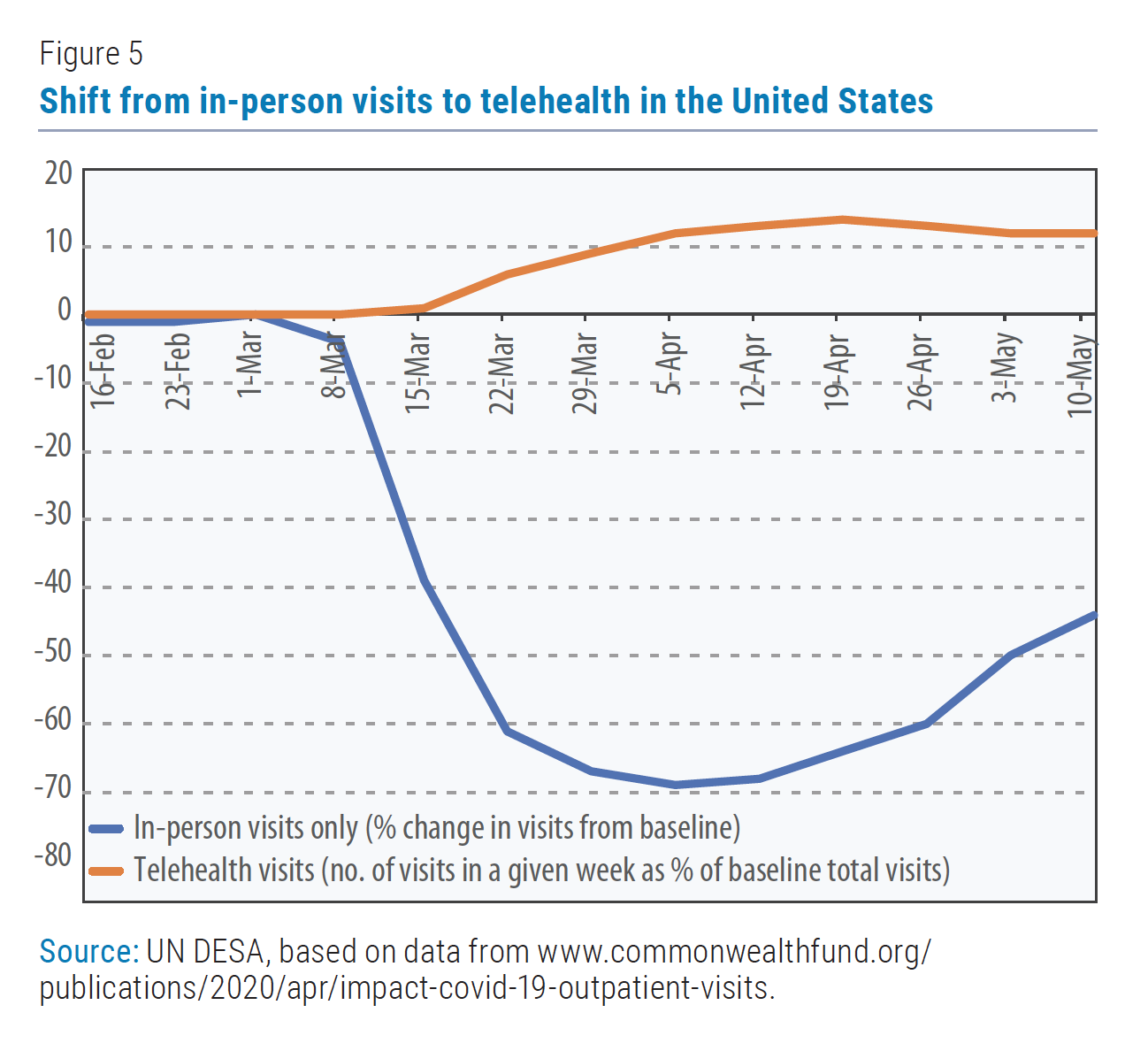 The current pandemic also shows how technology helps researchers collect data on large cohorts of patients in real-time. In Luxembourg, the Predi-COVID study looks at the factors associated with COVID-19 disease severity. It relies on a national surveillance system that gathers data from all patients who tested positive for COVID-19. This is combined with data on biological sampling, electronic patient-reported outcomes, and other innovative digital data sources, such as smartphone-based voice recording, to identify vocal biomarkers of respiratory syndromes. With the appropriate ethical safeguards, transparency and privacy norms, people and populations can benefit from personalized health services that leverage technologies like AI to improve health outcomes (Wei, 2017). This benefit is limited, however, to the populations who are well served by digital connectivity, highlighting the risks of higher inequality created by the digital divide.
The current pandemic also shows how technology helps researchers collect data on large cohorts of patients in real-time. In Luxembourg, the Predi-COVID study looks at the factors associated with COVID-19 disease severity. It relies on a national surveillance system that gathers data from all patients who tested positive for COVID-19. This is combined with data on biological sampling, electronic patient-reported outcomes, and other innovative digital data sources, such as smartphone-based voice recording, to identify vocal biomarkers of respiratory syndromes. With the appropriate ethical safeguards, transparency and privacy norms, people and populations can benefit from personalized health services that leverage technologies like AI to improve health outcomes (Wei, 2017). This benefit is limited, however, to the populations who are well served by digital connectivity, highlighting the risks of higher inequality created by the digital divide.
3. Remote learning during covid-19 and opportunities to reimagine education
The impact of COVID-19 on education has been a major concern, and with good cause. At the peak of nationwide and local lockdowns in March 2020, around 1.6 billion schoolchildren were affected by school closures. Thankfully, digital technologies offered an alternative to in-person learning and enabled children and students worldwide to continue learning during this challenging time. Multi-stakeholder partnerships between national governments, the private sector and other actors successfully enabled students to make use of existing digital learning tools, and in some cases developed new tools for digital learning. Many online educational enterprises and institutes provided free access and open curriculum resources for students during the pandemic. In many countries, teachers led real-time lessons using virtual meeting platforms. To foster equity in terms of access to digital learning, partnerships between governments and private companies helped distribute devices and exempted learning sites from data charges. Advanced technologies also helped make these platforms effective and accessible for as many students as possible. Algorithms enabled platforms to tailor lessons for individual students by observing a student’s proficiency, interests and learning style. Similarly, using machine learning for translation, online resources were made available in a range of different languages, making it accessible to more teachers and students beyond national borders and bringing down national barriers to education.
While digital learning solutions were adopted in many countries, countries also made use of low-tech solutions, such as television, radio and mobile phones to reach more learners. Leveraging and combining these low-tech solutions have been impactful for learning in many countries. For example, a study from Botswana assesses the impact of providing remote support via mobile phones to accompany radio broadcasts and found that this approach successfully engaged parents and enabled them to better support their children’s learning (Angrist et al., 2020). In other countries, where access to electricity is low, the distribution of printed material has been key to continue learning during the pandemic.
Despite a great effort by different stakeholders, the experience with remote learning during the pandemic has exposed how the technological divide interacts with education. One-third of the world’s schoolchildren (463 million) was cut off from education, unable to access remote learning due to a lack of remote learning policies, lack of equipment or connectivity needed for learning from home. Even when children have the technology at home, other factors impact their ability to participate in remote learning, such as pressure to do chores or work, a poor environment for learning and lack of support in using the remote learning resources. In many countries, remote learning resources are only available in the majority language, which is a restricting factor for children and parents speaking a minority language (UNICEF, 2020a). As a result, three out of four students who cannot access remote learning live in rural areas, and 72 per cent come from the poorest 40 per cent of families (UNICEF, 2020b). Also, the impact of school closures was not universal across countries. In countries with low human development, 86 per cent of children in primary education have been effectively out-of-school during the second quarter of 2020, while in countries with very high human development just 20 per cent were out-of-school (Figure 6).
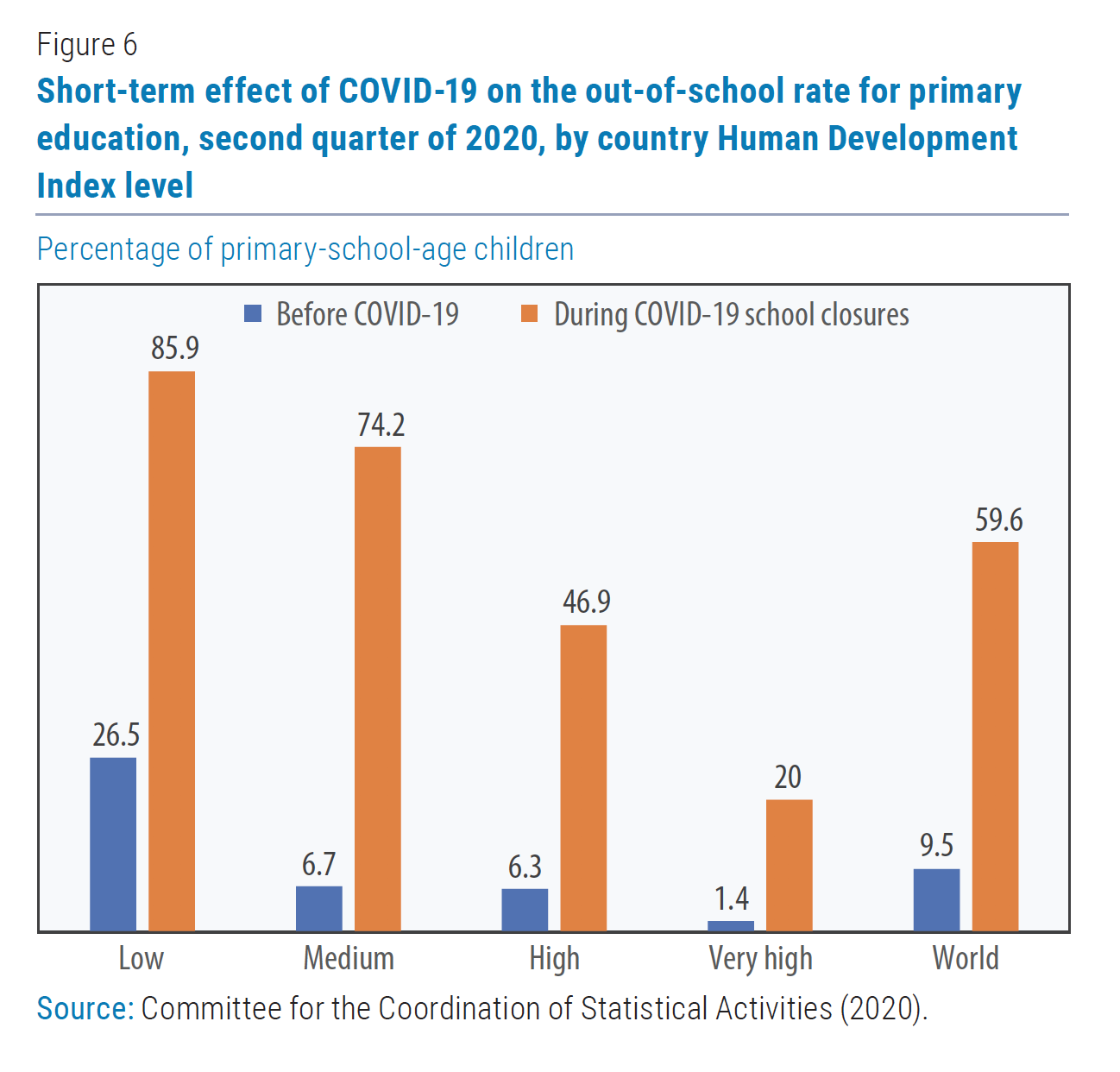 The extended time children are spending out-of-school is setting back their learning and development, and the impact is particularly concerning for children from poor households and in rural areas. Estimates from Chile show that while students from the richest quantile could lose 64 per cent of yearly learning, the poorest quantile risks losing 95 per cent (Centro de Estudios MINEDUC, 2020). This will arguably lead to an increase in the inequality of human capital growth for the affected cohorts within and between countries and may have long-term implications by reducing social mobility and increasing inequality (Burgess and Sievertsen, 2020).
The extended time children are spending out-of-school is setting back their learning and development, and the impact is particularly concerning for children from poor households and in rural areas. Estimates from Chile show that while students from the richest quantile could lose 64 per cent of yearly learning, the poorest quantile risks losing 95 per cent (Centro de Estudios MINEDUC, 2020). This will arguably lead to an increase in the inequality of human capital growth for the affected cohorts within and between countries and may have long-term implications by reducing social mobility and increasing inequality (Burgess and Sievertsen, 2020).
Despite these worries, the experience during the pandemic is likely to reshape education going forward. Already before the pandemic hit, the world was facing a global education crisis, and the pandemic has highlighted the role that technology in education can play as we build back better. As students, teachers and parents have experienced some of the benefits of using technology in education first-hand, it seems likely that some of these changes will stay even after the pandemic. Harnessing digital learning solutions can provide students with opportunities to have more agency and autonomy in learning, and learn skills such as critical thinking and adaptability, which are essential for success in the 21st century. The current situation can become a catalyst for more effective use of technology in education as the resistance to using technology will be lower. However, it is important to consider the implications of which technology we choose. Many governments are leaning towards high-tech solutions, in particular digital learning, at the expense of low- or no-tech solutions. But in all countries, even high-income countries, the technological divide is substantial and the appropriate balance between high, low and no-technology solutions, combined with in-person learning must be found. This would require a better assessment of the comprehensive effects of various methods for remote learning on different students and the complex ways in which these interact with pre-existing inequalities.
4. The way forward and building back better
So, can frontier technologies enable countries to build back better and put them back on the path to achieving the SDGs? The answer is they can, if they are made available for all, including the most vulnerable people and countries, by appropriate policy interventions at both the domestic and international levels.
Without policy interventions, technology dividends are not equally shared, which can widen the digital divide as well as inequalities. Governments must design context-specific policy measures that address these new challenges. The policies for building back better for decent work, improved health outcomes and better education must focus on improving infrastructure and access to technologies. It is not enough to ensure that technologies are available, but that the quality and coverage of the digital infrastructure should be guaranteed for all. Investments in training and improving digital literacy will be important for technology to offer opportunities to all. Policy interventions should account for behavioural insights that show people’s technology adoption behavior is not always perfectly rational and is shaped by habits, inclinations, and their interactions with other members in their communities (Brown et al., 2013). Moreover, relevant fiscal policies, social protection programmes and regulatory reforms need to be in place to protect the most vulnerable.
As technology becomes more important for work, health and education, technology companies will amass an increasing amount of data. This raises concerns not only over data breaches and cyberattacks, but also over the ability of companies to profile, track and surveil individuals. It is important that protecting data privacy and cybersecurity becomes a priority for governments and that rights are codified in laws. At the same time, regulators must be on alert to prevent the excessive concentration of economic power by digital companies and the creation of entrenched oligopolies and monopolies.
The section below discusses the policies necessary to realize the potential of digital technologies in the areas of work, health, and education, keeping in mind the overlaps and complementarities that exist between them.
Shaping the future world of work
To ensure frontier technologies contribute to the creation of decent work for all, policies must promote job-generating technologies and maximizing their employment effects. These can be done through a three-pronged approach:
+ Fiscal support, such as direct subsidies and tax incentives (e.g. tax credits, special deductions for labour taxes or social security contribution, etc.), towards the adoption of technologies that hold potential for creating new jobs or tasks that allow workers to earn a living wage with dignity;
+ Investment in occupational training that is continuously updated to reflect the changing demand in the labour market and which help workers to obtain skills that are complementary to, rather than replaceable by, robotics and AI; and
+ Social protection programmes that help workers transition into new, productive jobs.
The proposition regarding universal basic income (UBI) should also be considered, as it could allow workers to prepare for and pursue meaningful jobs in a labour market that is constantly reshaped by technologies, rather than immediately jumping on a job opportunity—even a bad one—because of subsistence needs. Given the rising incidence of nonstandard employment (e.g. temporary and part-time employment) partly fostered by technological changes, UBI also presents a possible advantage over traditional contributory social protection systems that assume single, stable, full-time employment relationships (Gentilini, and others, 2020).
As countries continue to embrace digitalization, there is also a risk that inadequate technological sophistication could make it difficult for some, especially the technologically-challenged people, to effectively assert their rights to social protection (Alston, 2020). The increasing use of AI and predictive algorithms in assessing the eligibility of individuals for benefits, as well as in determining and dispersing payments, also makes the operation of social protection systems more opaque and mistakes harder to rectify. Improving transparency about how these automated decisions are made and addressing the biases embedded in data used for algorithm training are important to ensure that digitalized social protection systems do not neglect or mistreat disadvantaged groups and instead allows equal opportunities for every worker to enjoy what social protection can offer in facilitating the transition between jobs.
A focus on health outcomes and on closing the digital divide
Policy-making must reflect that health is not synonymous with healthcare. Building better health systems is a means to achieve the goal of better health outcomes. However, better health systems must also be complemented by policies that address the determinants of health risks and vulnerabilities. Technology has a role to play in all these aspects, enabling new models of health delivery to function, helping to inform governments on the progress of social determinants of health in communities, and helping health administrators to monitor the impact of policy interventions.
Equitable sharing of the benefits of digital technologies in achieving health goals is not possible without addressing the large digital divide that exists in accessing health technologies. The following four health-specific policy strategies can help to accelerate the diffusion and adoption of the required technology:
+ The global community can work to lower economic and legal barriers for firms in developing countries to access health technologies and services. Policies must also consider how to improve the digital skills of users, SMEs, and public sector agencies to help them make the best use of digital opportunities.
+ Within countries, policies should strongly focus on removing cost and infrastructure obstacles to expanding digital health solutions by reducing the high telecommunication costs and building infrastructure (computers, internet networks, and electricity).
+ Governments must build on recent innovations as a foundation of a new model of health delivery, making the appropriate regulatory changes and providing sustainable funding for companies to develop, operate, and maintain digital platforms. Such funding would encourage ICT innovations across technologies, business models, and regulations.
+ Finally, as medical data and services become widely used, national and institutions must support rules-based regimes for data that promote national and collective interests. It will be necessary, for example, to establish the appropriate boundaries of acceptable use of data for medical research with particular attention to securing data privacy and safeguarding against cybersecurity threats (Cheng, LaFleur and Rashid, 2019).
Harnessing technology for better education
One of the key lessons from COVID-19 is that remote education using appropriate technologies can benefit learning and should be an integrated component of education systems. Below are some policies that can help to make successful use of digital technologies in education until the pandemic is brought under control and for building back better and achieving the SDGs:
+ Every country must choose the optimal mix of technologies, based on access, technical infrastructure and available content to make learning opportunities available to as many students and as quickly as possible.
+ There is an urgency to reduce the impact of the digital divide on education. Distribution of devices and exempting e-learning sites from data charges are important first steps but bridging the digital divide will also require efforts to enhance digital literacy for marginalized populations. Digital solutions that are institutionalized in the aftermath of the pandemic need to put equity and inclusion at the centre.
+ The promotion of multi-level and cross-sectoral partnerships will be crucial to bridge the digital divide, and governments need to work with different partners to remove technological barriers by investing in digital infrastructure and lowering connectivity costs.
+ In most countries, the immediate priority has been access to remote learning, perhaps rightly so. Going forward, as more focus will be necessary on building back better, emphasis on the quality of remote learning will need to follow. Thus, remote learning solutions must adhere to sound pedagogical principles.
+ The transition to digital learning raises questions about data ownership and ethics, and governments and other stakeholders must take measures to protect the privacy and security of data. There is a risk that a few technology companies will dominate the market of digital education, and governments must take appropriate measures to guard against excessive concentration of the market for digital education.

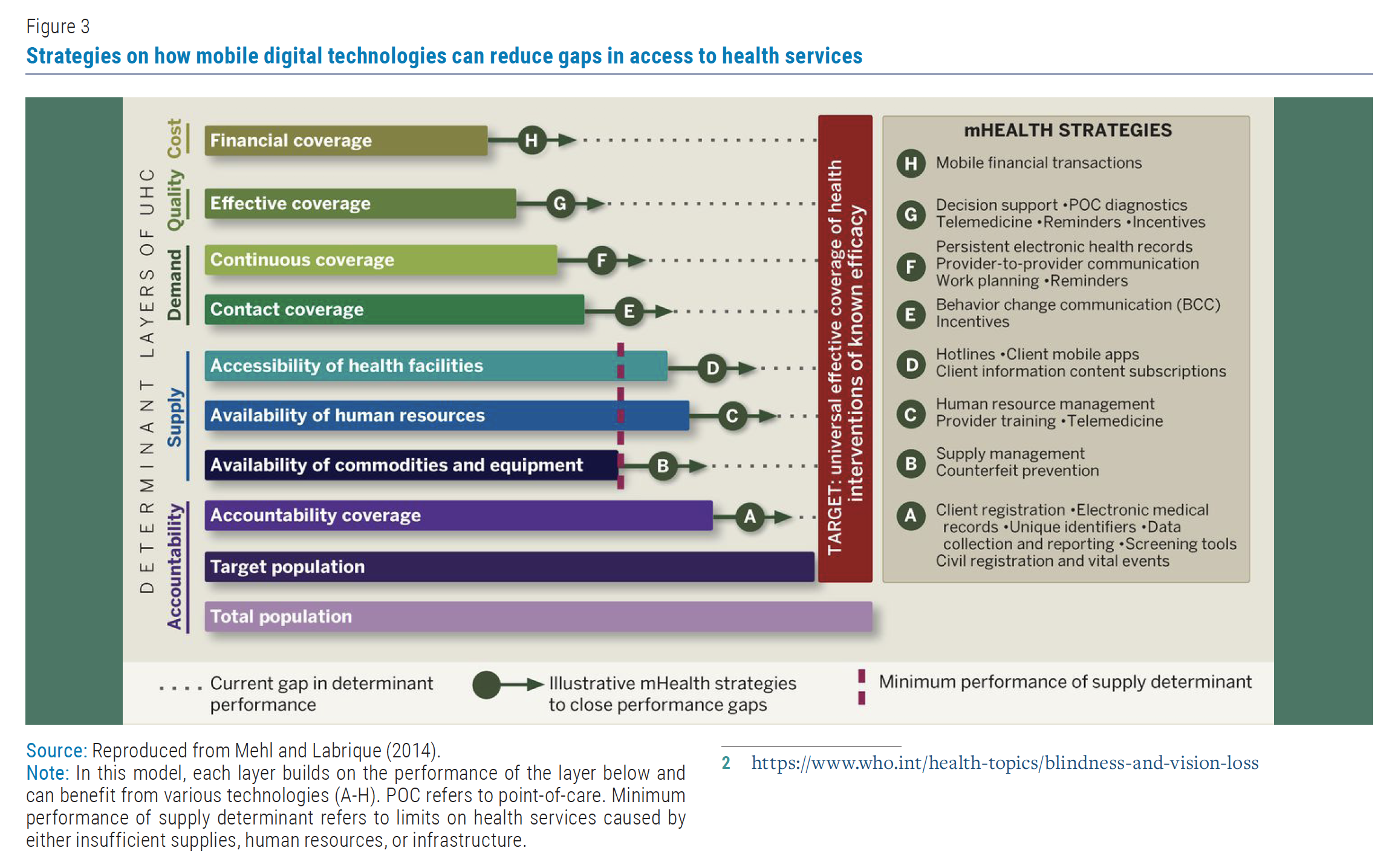
Follow Us